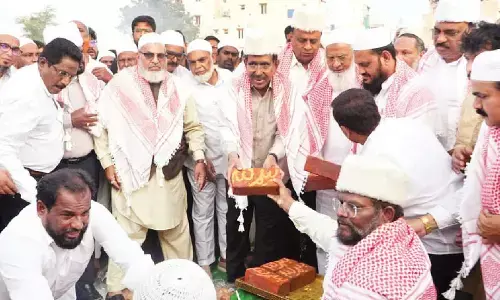Dr Arvind Subramanian addresses UoH students on big ideas

Speaking at a session on Economic Survey Outreach 2014-15 organised by the School of Economics, Dr Arvind Subramanian, India’s Chief Economic Adviser explained the big ideas presented in the Economic Survey 2014-15, to students, faculty and staff at the University of Hyderabad (UoH), on Tuesday.
Hyderabad: Speaking at a session on Economic Survey Outreach 2014-15 organised by the School of Economics, Dr Arvind Subramanian, India’s Chief Economic Adviser explained the big ideas presented in the Economic Survey 2014-15, to students, faculty and staff at the University of Hyderabad (UoH), on Tuesday.
.jpg) Dr Subramanian presented ‘push for public investment’ as the first big idea. “There are many investment challenges; balance sheet syndrome with India characteristic hold back private investment. Many countries have good bankruptcy laws where promoters, bankers, owners etc. come together and find a way out when a business is not performing badly. In India, we don’t have effective exit ways.
Dr Subramanian presented ‘push for public investment’ as the first big idea. “There are many investment challenges; balance sheet syndrome with India characteristic hold back private investment. Many countries have good bankruptcy laws where promoters, bankers, owners etc. come together and find a way out when a business is not performing badly. In India, we don’t have effective exit ways.
Our bureaucracy is not empowered to take decisions that are conducive for the public investment. These aspects present negative case for public investment and these institutional issues need to be addressed to facilitate public investment that is much needed for the economy,” he stressed at the meet. Dr Subramanian also mentioned that skill development is an under-invested area and railways can also attract public investment in NDA-II regime.
The second big idea highlighted at the session was fiscal consolidation path. Dr Subramanian said that growth and fiscal consolidation are compatible with each other. “India is now looking for a target of 3.9 per cent and not of 3.6 per cent and there are sufficient rationales to achieve this,” he added.
Dr Subramanian emphasised upon promoting ‘competitive federalism’ as the third big idea which can be the agent of change and can bring much the needed dynamism in achieving our developmental goals. Underlining its importance he said, “Federalism is India’s future; we must sustain it with balance between equity and efficiency in our policies. States can act as “models” and “magnets” for different areas. Democratic politics is facilitating competitive federalism where states compete with each other for good. We need to further support this progressive move through facilitative decentralization.”
As fourth big idea, Dr Subramanian presented the role of Jan Dhan Yojana, Aadhar and Mobile, the trinity, which can check some of the issues pertaining to these schemes effectively. “As a fair economic practice, both the producers and the consumers should face the marketplace however; poor people should be given proper assistance from the state. The cost of subsidy at present amounts to 4.2 per cent of the GDP. Although, this expenditure should bring much relief to the poor people, we don’t achieve satisfactory result due to leakages and inefficiencies in delivery mechanism.
The above trinity can ensure these supplies can reach the actual beneficiaries effectively,” Dr Subramanian stressed. Dr Subramanian also quoted John Maynard Keynes- “It is ideas, not vested interests, which are dangerous for good or evil.” He further added that the ‘Economic Survey’ should be seen as a repository of facts and data, a technical analysis and as an idea generating document for the economy. Post the session, Dr Submanian also interacted with the students and other dignitaries present.
Economic Survey 2014-15 attempts to capture the “Big Picture: India’s Sweet Spot”:
- A moment that comes “but rarely in history”.
- Political mandate plus benign external environment that brings possibility of achieving sustained double digit growth.
- These need to be utilized to:
- Wipe every tear from every eye.
- Create opportunity for young, middle class and aspiring Indians.
- But the question is how to achieve this sustained growth? Big Bang Reforms are the way forward. Our understanding of Big Bang Reforms goes as following:
- Post war cross country evidence suggests that Big Bang Reforms occur during or in the aftermath of a major crisis.
- Big Bang Reforms in robust democracies with multiple actors and institutions with the power to do undo and block an exceptions rather than rule.
- With a bold policy shift in are under government control, plus “a persistent, encompassing and creative incrementalism” in other areas can cumulate to a Bang.
















